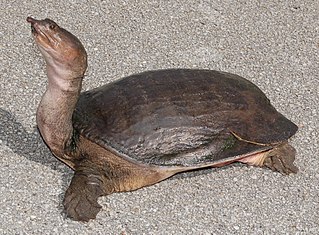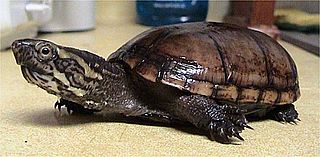
The Kinosternidae are a family of mostly small turtles that includes the mud turtles and musk turtles. The family contains 25 species within four genera, but taxonomic reclassification is an ongoing process, so many sources vary on the exact numbers of species and subspecies. They inhabit slow-moving bodies of water, often with soft, muddy bottoms and abundant vegetation.

The common snapping turtle is a species of large freshwater turtle in the family Chelydridae. Its natural range extends from southeastern Canada, southwest to the edge of the Rocky Mountains, as far east as Nova Scotia and Florida. The three species of Chelydra and the larger alligator snapping turtles are the only extant chelydrids, a family now restricted to the Americas. The common snapping turtle, as its name implies, is the most widespread.

The mata mata, mata-mata, or matamata is a South America species of freshwater turtle found in the Amazon basin and river system of the eastern Guianas. It was formerly believed to also occur in the Orinoco basin, western Guianas and upper Rio Negro–Branco system, but in 2020 these populations were found to belong to a separate species, Chelus orinocensis. Subsequently, some authorities have modified the common name of Chelus fimbriata to Amazon mata mata. These two are the only extant species in the genus Chelus.

The Blanding's turtle is a semi-aquatic turtle of the family Emydidae. This species is native to central and eastern parts of Canada and the United States. It is considered to be an endangered species throughout much of its range. The Blanding's turtle is of interest in longevity research, as it shows few or no common signs of aging and is physically active and capable of reproduction into eight or nine decades of life.

The alligator snapping turtle is a large species of turtle in the family Chelydridae. The species is native to freshwater habitats in the United States. M. temminckii is one of the heaviest freshwater turtles in the world. It is the largest freshwater species of turtle in North America. It is often associated with, but not closely related to, the common snapping turtle, which is in the genus Chelydra. The specific epithet temminckii is in honor of Dutch zoologist Coenraad Jacob Temminck.

The painted turtle is the most widespread native turtle of North America. It lives in relatively slow-moving fresh waters, from southern Canada to northern Mexico, and from the Atlantic to the Pacific. They have been shown to prefer large wetlands with long periods of inundation and emergent vegetation. This species is one of the few that is specially adapted to tolerate freezing temperatures for extended periods of time due to an antifreeze-like substance in their blood that keeps their cells from freezing. This turtle is a member of the genus Chrysemys, which is part of the pond turtle family Emydidae. Fossils show that the painted turtle existed 15 million years ago. Three regionally based subspecies evolved during the last ice age. The southern painted turtle is alternately considered the only other species in Chrysemys, or another subspecies of C. picta.

The spotted turtle, the only species of the genus Clemmys, is a small, semi-aquatic turtle that reaches a carapace length of 8–12 cm (3.1–4.7 in) upon adulthood. Their broad, smooth, low dark-colored upper shell, or carapace, ranges in its exact colour from black to a bluish black with a number of tiny yellow round spots. The spotting patterning extends from the head, to the neck and out onto the limbs. Sexually mature males have a concave plastron and a long, thick tail. By contrast, sexually mature females possess a flat plastron and have a tail that is noticeably shorter and thinner than that of mature males. Mature males also have a dark iris and face; females typically have a yellow or orange iris and a similarly coloured face that is distinctly lighter than the males'. Juveniles appear female-like in this regard, and at maturity males begin to develop darker features.

The chicken turtle is a turtle native to the southeastern United States. It is the only extant member of the genus Deirochelys and is a member of the freshwater marsh turtle family Emydidae. The chicken turtle's scientific name refers to its extremely long neck and distinctive net-like pattern on its upper shell. There are three regionally distinct subspecies, which are thought to have evolved when populations became separated during periods of glaciation. These subspecies can be distinguished by their appearance; the western chicken turtle displays dark markings along the seams of its plastron, while the plastron of the Florida subspecies is a bright yellow or orange color. Fossil records show that the chicken turtle has been present in the region for up to five million years.

The European pond turtle, also called commonly the European pond terrapin and the European pond tortoise, is a species of long-living freshwater turtle in the family Emydidae. The species is endemic to the Western Palearctic.

The eastern long-necked turtle is an east Australian species of snake-necked turtle that inhabits a wide variety of water bodies and is an opportunistic feeder. It is a side-necked turtle (Pleurodira), meaning that it bends its head sideways into its shell rather than pulling it directly back.

Sternotherus is a genus of turtles in the family Kinosternidae including six species commonly known as musk turtles. The genus is endemic to North America, occurring in the eastern third of the US and southeast Ontario, Canada. Musk glands positioned near the bridge of the shell can produce foul smelling secretions when the turtles are threatened, although gentle handling does not normally provoke a response. Sternotherus are moderately small turtles, with the largest species in the genus, the razor-backed musk turtle, attaining a maximum of 17.6 cm. in shell length. The carapace is characteristically oval and domed, with most species having one or three keels on the back which may become smoother and obscure with age in some species. Musk turtles are generally drab in color, mostly black, gray, brown, olive, or ocher, which aid in camouflaging them in their natural habitats. The head is relatively large and stout, marked with spots, streaks, or strips. The plastron has only 10 or 11 scutes, as opposed to 12, a more common condition in North American turtles. The tail is short, with males having a horny claw like tip.

The razor-backed musk turtle is a species of turtle in the family Kinosternidae. The species is native to the southern United States. There are no subspecies that are recognized as being valid.

The spiny softshell turtle is a species of softshell turtle, one of the largest freshwater turtle species in North America. Both the common name, spiny softshell, and the specific name, spinifera (spine-bearing), refer to the spiny, cone-like projections on the leading edge of the carapace, which are not scutes (scales).

The Florida softshell turtle is a species of turtle in the family Trionychidae. The species is native to the Southeastern United States.

The yellow mud turtle, also commonly known as the yellow-necked mud turtle, is a species of mud turtle in the family Kinosternidae. The species is endemic to the Central United States and Mexico.

The Cumberland slider, also called commonly the Cumberland turtle and Troost's turtle, is a subspecies of pond slider, a semiaquatic turtle in the family Emydidae. The subspecies is indigenous to the Southeastern United States.

The northern map turtle, also known as the common map turtle, is an aquatic turtle in the family Emydidae. It is endemic to North America.

The eastern mud turtle or common mud turtle is a common species of turtle in the family Kinosternidae. The species is endemic to the United States. There are two recognized subspecies.

The loggerhead musk turtle is a species of turtle in the family Kinosternidae. This turtle has a large head which has a light-colored background with dark spots or stripes present on the head and neck. The average size of an adult loggerhead musk turtle is about 3–5 in (7.6–12.7 cm) in straight carapace length.

The common watersnake is a species of large, nonvenomous, common snake in the family Colubridae. The species is native to North America. It is frequently mistaken for the venomous cottonmouth.























